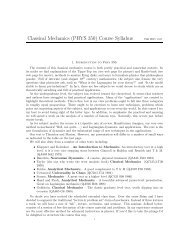Leek Scientific Classification and Etymology - Academics - Hamilton ...
Leek Scientific Classification and Etymology - Academics - Hamilton ...
Leek Scientific Classification and Etymology - Academics - Hamilton ...
Create successful ePaper yourself
Turn your PDF publications into a flip-book with our unique Google optimized e-Paper software.
of the bulb, <strong>and</strong> rarely attacks active parts of the plant. Symptoms include tiny green <strong>and</strong><br />
black dots, often arranged concentrically, on outer scales <strong>and</strong>, on colored varieties of<br />
onion, sunken yellowish splotches on fleshy scales. Onion smudge tends to form in<br />
warm, moist conditions, <strong>and</strong> its threat can thus<br />
be minimized by thoroughly drying plants after<br />
harvest. 31<br />
White Rot (Phanerochaete chyrsosporium):<br />
First observed in Engl<strong>and</strong> in the mid-1800’s,<br />
white rot tends to form in dry soil exposed to<br />
cool temperatures. The disease spreads rapidly<br />
when it attacks young plants. External signs of<br />
infection include yellowing <strong>and</strong> necrosis of<br />
leaf tips. Bulb scales may become spongy, become covered with white mycelium (the<br />
vegetative part of the white rot fungus), <strong>and</strong><br />
develop black sclerotia (a compact mass of<br />
hardened sclerotia). Treatment with chemical<br />
Garlic bulbs infected with the white rot<br />
fungus (http://www. garlicworld.co.uk/<br />
images/rot.gif).<br />
agents such as mercuric chloride, lime, <strong>and</strong> 2,6-dichloro-4-nitroaniline has proven<br />
effective. 32<br />
Neck Rot (Botrytis allii): This disorder is caused by three different species of the fungus<br />
Botrylis <strong>and</strong> is probably the most widely distributed <strong>and</strong> most destructive disease of<br />
storage onions. The illness was documented in Germany in 1876, the United States in<br />
1890, <strong>and</strong> Engl<strong>and</strong> in 1894. Though infection occurs in the field, it is usually not noticed<br />
until after harvest. Symptoms include softening of bulb scales <strong>and</strong> the development of<br />
sunken brown lesions, with an observable boundary between fresh <strong>and</strong> tainted tissue.<br />
Over time, the bulb desiccates <strong>and</strong> collapses. White cultivars tend to be more vulnerable<br />
to the ailment than do colored varieties. Neck rot can be controlled through careful<br />
h<strong>and</strong>ling during harvest <strong>and</strong> providing sufficiently cool <strong>and</strong> dry storage conditions.<br />
Spraying with Zineb or carbamate can help combat infection after it has occurred. 33<br />
Soft Rot (Erwina carotovora): This bacterial rot does most of its damage to onions <strong>and</strong><br />
other alliums during storage. It usually begins at the neck of the bulb <strong>and</strong> affects one or<br />
more scales, though does not spread rapidly from one to another. External symptoms<br />
include a lack of firmness <strong>and</strong> a foul-smelling discharge from the neck when the affected<br />
vegetable is squeezed. Soft rot tends to form in humid weather, <strong>and</strong> so growers in tropical<br />
climates must take care to rapidly <strong>and</strong> thoroughly dry bulbs at harvest. 34<br />
Aster Yellows: Aster yellow is a virus spread by the six-spotted leafhopper that can affect<br />
carrots, celery, <strong>and</strong> lettuce in addition to onions. The leaves of infected plants appear<br />
light-yellow, though in many cases only one part of the plant will display symptoms.<br />
Shoots may also become discolored, <strong>and</strong> roots often become short <strong>and</strong> twisted.<br />
Controlling the virus typically involves eradicating the leafhopper population. 35<br />
Onion Thrips (Thrips tabaci): Among insects that can attack onions <strong>and</strong> other allium<br />
plants, the onion thrip can do some of the most significant damage. The thrip punctures<br />
5






